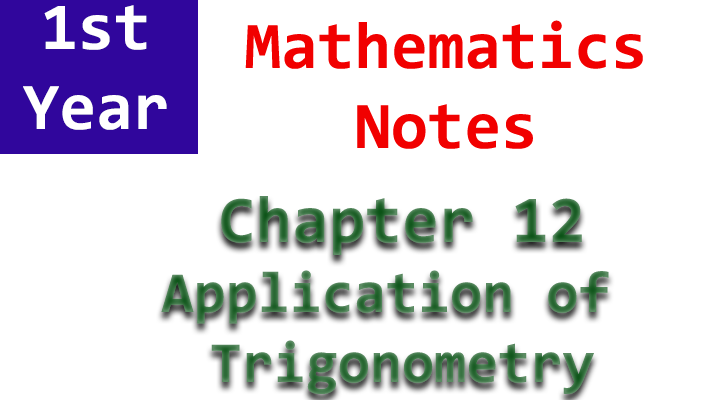In mathematics, trigonometry is a fascinating and indispensable branch that finds applications in various fields of science, engineering, and everyday life. Chapter 12 of the F.Sc 1st Year Math curriculum delves into the intricate world of trigonometry and its practical applications. Trigonometry, often regarded as the study of triangles, goes far beyond its geometric origins, serving as a powerful tool for solving complex problems involving angles and distances.
In this chapter, we will explore the fundamental concepts of trigonometry and delve into its real-world applications, equipping students with the knowledge and skills necessary to tackle a wide range of challenges in mathematics and beyond. From analyzing the heights of towering structures to navigating through the depths of space, the applications of trigonometry are boundless, and this chapter serves as an essential stepping stone in understanding and harnessing its immense potential.
A triangle comprises six essential components: three angles and three sides. In the case of a triangle denoted as ABC, the measures of the three angles are typically represented as a, b, and c, while the measures of the three sides opposite them are denoted as a, b, and c, respectively.
Given any three of these six elements, with at least one side among them, it becomes possible to determine the remaining three elements. This process of identifying the unknown elements is referred to as the solution of the triangle.
In previous calculations, we have computed the values of trigonometric functions for angles measuring 0°, 30°, 45°, 60°, and 90°. However, within a triangle, angles may not necessarily be limited to these specific values. Therefore, when solving triangles, we might encounter problems involving angles of different measurements. In such cases, we will need to refer to natural sine, cosine, and tangent tables or utilize the sine (sin), cosine (cos), and tangent (tan) functions on calculators.
Mathematicians have developed tables that provide the values of trigonometric ratios for numerous angles ranging from 0° to 90°. These tables are known as tables of natural sines, cosines, tangents, and so forth. In these four-figure tables, the interval is set at 6 minutes, and the differences corresponding to 1, 2, 3, 4, and 5 minutes are listed in the difference columns.
To illustrate how to use these tables, consider the following examples:
Example 1:
i) Find the value of sin 38° 24’.
ii) Find the value of sin 38° 28’.
iii) Find the value of tan 65° 30’.
Solution:
i) For sin 38° 24’, locate 38° in the leftmost column labeled degrees in the Natural Sine table. Follow the row of 38° until you reach the column for 24 minutes, resulting in the number 0.6211.
Therefore, sin 38° 24′ = 0.6211.
ii) To find sin 38° 28’, start by locating sin 38° 24’. Then, in the right-hand column labeled mean differences, look for the row corresponding to 4 minutes. Add 9 (the difference for 4 minutes) to 0.6211, resulting in 0.6220.
Therefore, sin 38° 28′ = 0.6220.
iii) For tan 65° 30’, consult the tables of Natural Tangents. Find 65° in the leftmost column for degrees and follow the row to the column under 30 minutes, yielding the number 1943. The integral part of the figure next to 65° on the horizontal line is 2.
Hence, tan 65° 30′ = 2.1943.
Example 2: If sin x = 0.5100, find the value of x.
Solution: In the tables of Natural Sines, locate the number 5090 (closest to 5100), which lies at the intersection of the row starting with 30° and the column labeled 36’. The difference between 5100 and 5090.

